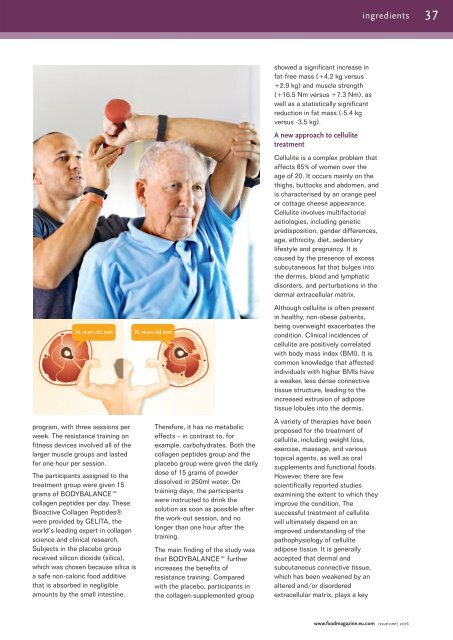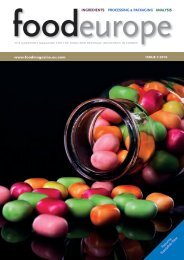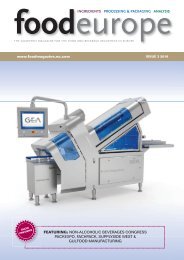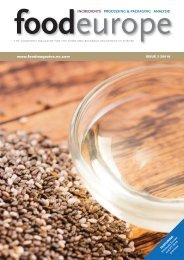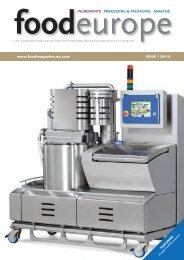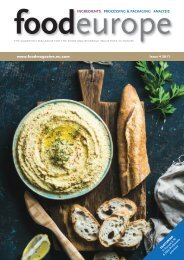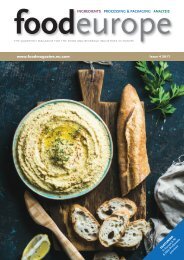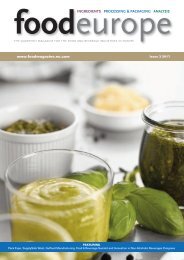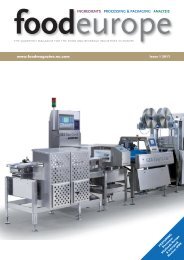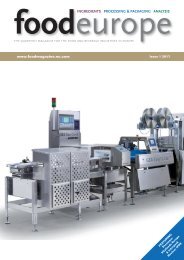Issue_1_2016
Create successful ePaper yourself
Turn your PDF publications into a flip-book with our unique Google optimized e-Paper software.
ingredients 37<br />
program, with three sessions per<br />
week. The resistance training on<br />
fitness devices involved all of the<br />
larger muscle groups and lasted<br />
for one hour per session.<br />
The participants assigned to the<br />
treatment group were given 15<br />
grams of BODYBALANCE<br />
collagen peptides per day. These<br />
Bioactive Collagen Peptides®<br />
were provided by GELITA, the<br />
world’s leading expert in collagen<br />
science and clinical research.<br />
Subjects in the placebo group<br />
received silicon dioxide (silica),<br />
which was chosen because silica is<br />
a safe non-caloric food additive<br />
that is absorbed in negligible<br />
amounts by the small intestine.<br />
Therefore, it has no metabolic<br />
effects – in contrast to, for<br />
example, carbohydrates. Both the<br />
collagen peptides group and the<br />
placebo group were given the daily<br />
dose of 15 grams of powder<br />
dissolved in 250ml water. On<br />
training days, the participants<br />
were instructed to drink the<br />
solution as soon as possible after<br />
the work-out session, and no<br />
longer than one hour after the<br />
training.<br />
The main finding of the study was<br />
that BODYBALANCE further<br />
increases the benefits of<br />
resistance training. Compared<br />
with the placebo, participants in<br />
the collagen-supplemented group<br />
showed a significant increase in<br />
fat-free mass (+4.2 kg versus<br />
+2.9 kg) and muscle strength<br />
(+16.5 Nm versus +7.3 Nm), as<br />
well as a statistically significant<br />
reduction in fat mass (-5.4 kg<br />
versus -3.5 kg).<br />
A new approach to cellulite<br />
treatment<br />
Cellulite is a complex problem that<br />
affects 85% of women over the<br />
age of 20. It occurs mainly on the<br />
thighs, buttocks and abdomen, and<br />
is characterised by an orange peel<br />
or cottage cheese appearance.<br />
Cellulite involves multifactorial<br />
aetiologies, including genetic<br />
predisposition, gender differences,<br />
age, ethnicity, diet, sedentary<br />
lifestyle and pregnancy. It is<br />
caused by the presence of excess<br />
subcutaneous fat that bulges into<br />
the dermis, blood and lymphatic<br />
disorders, and perturbations in the<br />
dermal extracellular matrix.<br />
Although cellulite is often present<br />
in healthy, non-obese patients,<br />
being overweight exacerbates the<br />
condition. Clinical incidences of<br />
cellulite are positively correlated<br />
with body mass index (BMI). It is<br />
common knowledge that affected<br />
individuals with higher BMIs have<br />
a weaker, less dense connective<br />
tissue structure, leading to the<br />
increased extrusion of adipose<br />
tissue lobules into the dermis.<br />
A variety of therapies have been<br />
proposed for the treatment of<br />
cellulite, including weight loss,<br />
exercise, massage, and various<br />
topical agents, as well as oral<br />
supplements and functional foods.<br />
However, there are few<br />
scientifically reported studies<br />
examining the extent to which they<br />
improve the condition. The<br />
successful treatment of cellulite<br />
will ultimately depend on an<br />
improved understanding of the<br />
pathophysiology of cellulite<br />
adipose tissue. It is generally<br />
accepted that dermal and<br />
subcutaneous connective tissue,<br />
which has been weakened by an<br />
altered and/or disordered<br />
extracellular matrix, plays a key<br />
www.foodmagazine.eu.com issue one | <strong>2016</strong>


